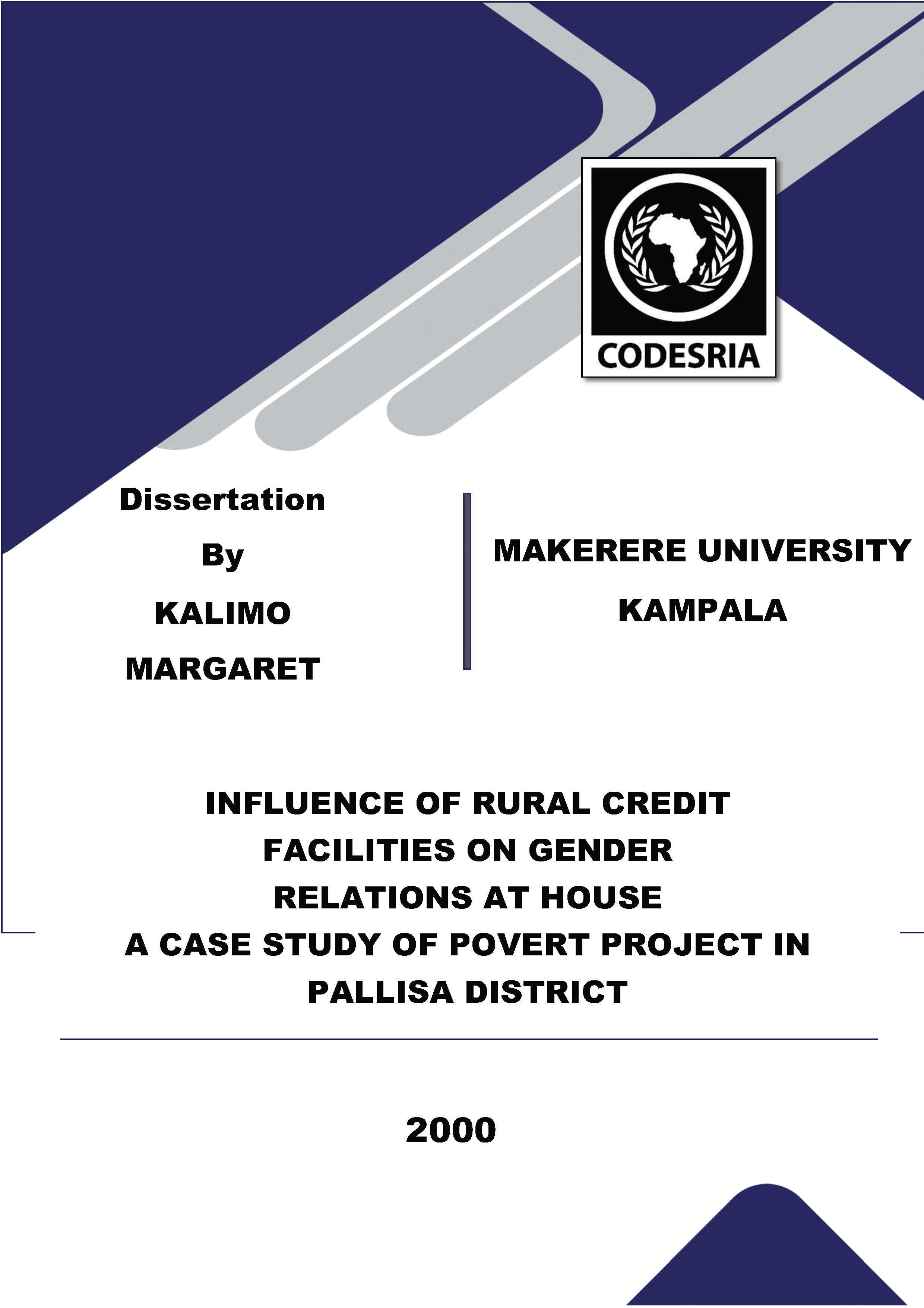INFLUENCE OF RURAL CREDIT FACILITIES ON GENDER RELATIONS AT HOUSE A CASE STUDY OF POVERT PROJECT IN PALLISA DISTRICT
Mots-clés :
RURAL CREDIT FACILITIES, GENDER RELATIONS, HOUSE, PALLISA DISTRICTSynopsis
Rural credit facilities in the country have been seen as one of the ways of initiating development and eradicating poverty. particularly in rural areas. The study sought to examine the influence rural credit facilities has on gender-relations at
household level. Benefits were identified for both men and women and the influence on power relations and poverty in the household was found. The findings showed that access to credit leads to changes in power relations, for example change in decision making, gender roles, increased bargaining power. The gender-relations in terms of access and control favoured more men than women. To some extent benefits were equally obtained, but when it came to control over them conflicts arose. Bath men and women respondents were able to acquire financial and physical assets but what varied was the type of asset each individual acquired. They also attained leadership qualities that they did not have before, however this does not mean ail individuals benefited. As indicated in the findings, some of them did not. Meanwhile, alongside access to credit, there are constraint factors, which limited empowerment of PAP clients in the study area such as lack of confidence, illiteracy. Based on the study findings, access to PAP credit facilities has led to changes in gender roles of some beneficiaries, joint planning, cooperation, and conflicts in some households. This indicates that there have been positive and negative benefits. Therefore the study recommends that a gender analysis appraisal should be performed so that they gauge household relations in order to have a clear understanding of men and women. It also recommends that women's bargainîng power needs to be improved and enhanced as they operate from a weak socio- economic positim1 in the sense that they have limited access to property which is needed as security for obtaining loans from financial institutions. Furthermore, women as well as men need increased access to appropriate financial services such as savings, deposits and credit in order to alleviate poverty
Téléchargements
Références
Bruce J. and Dwyer, (1988): "Home Divided" in World Development, The Population Council, New York.
Cloves (1991) in Holt H. Shavon and Ribe Helen (1991) Developing Financial Institutions for the Poor and Reducing Barriers to Access for Women, World Bank. Discussion Papers. The World°Bank Washington.
Devereux S. and Pares H. (1990): Credit and Savings for Development; Oxfam Print Unit, and Oxford.
Ebon (1995) and Goetz et al. cited in Rajasekhar, D. Impact of Micro Credit Programmes on'Poverty,well being and Gender inequality: Sorne evidence from Indian NGOs.11 A paper prepared for the UNRISD/UNDP/CDs workshop. Gender Poverty and well being Indicators and strategies. Trivandrum, Kerala, India 24 - 27.
FAO (1997) Gender: Key to Sustainability and Food Security: Plan for Action for Women in Development (1996 -2001), FAO-Rome.
Foundation for :Oevelopment Co-operation (1992), Unpublished Report on Banking in Malaysia.
Galukadde (1992): Reaching'Rùral Wonien. An appraisal of informai creditJor Ugandan Women. Unpublished M.A Dissertation Women and Gender Studies Makerere University, Kampala.
Gangopadhyay and Sengupta (1987) in Hilhorst Thea and Oppenoath H. (1992); Financing Women's Enterprise Beyond Barriers and Bias, Royal Tropical Institute, Amsterdam Technical Publications United Kingdom UNFEM.
Herzer M. and Sen G. (1994): Gender, Economie Growth and Poverty, Market Growth and State Planning
in Asia and the Pacifie, Asia and Pacifie Development Center, Kual.
Hilhost T. and Oppnoorth H. (1992), Financing Women's Enterpdse: Beyond Barriers and bias,_Royal Tropical institute, Amsterdam.
Holts H. and Ribe H. (1991): Developing Financial Institutions for the Poor .and Reducing Gender Barriers: Washington, World Bank, Research and External Affairs.
IFAD/FAO FARMESA (1998): A Joint Study The Potential for Improving. production Tools and lmplements used by Women Rarmers in Africa. A case study ofZ1mbabwe. Rome: FAO.
Nyerere, J. (1992): Accessing Women to Credit: in United Nations Economie Commission for Africa. A packaged Approach, African Training and Research Centre for Women, Addis Ababa.
Rhyne, E. and Otero, M. (1990): "Financial Services for Micro-Enterprises: Principles and Institutions" in World Development Vol. 20. 18-26
Shapiro J and Maynes G. (1980): Report of International Workshop of Women in Banking and Finance, Amsterdam, March 12 - 15.
Staudt, K. (1978): "Agricultural Productivity": A Case Study of Male Preference in Governrnent Policy Implementation, Development and Change Vol. 9 No. 3: 439 - 457.
Tibikoma, AM. (1994):"lmpact of Culture on Informai Credit Systems" A study of Women in Busoga, .informai and Institutional Credit in Uganda. A Research paper, Ministry of Gender, Culture and Youth.
Uganda Governrnent (1997): Poverty Eradication Action Plan. Uganda Governrnent Printers, Entebbe
Wavanmno, C. (1991): Women's Credit Situation in Development Finance, Department of the Bank of Uganda. Bank of Uganda Publications Kampala,
Wheat, S. (1997): The Future for Micro-Enterprises: Banking the UnBankable Panos Media Briefing, No. 21 January 1997, Panos London.






